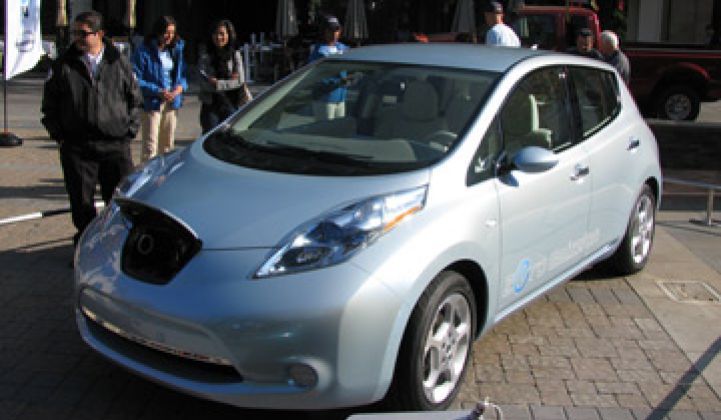PALO ALTO, Calif. --- New owners are generally enthusiastic about their all-electric Nissan Leafs.
They are also finding themselves stuck on the side of the road occasionally when the battery runs out.
Three different participants at Charged 2011, a two-day symposium on electric transportation sponsored by the Silicon Valley Leadership Group taking place this week at SAP’s offices in Palo Alto, shared stories about how their Leafs ran out of power at inconvenient times.
While the speakers weren’t anti-EV, the first-hand anecdotes underscored the need for public charging networks and stations, the need for new EV owners to think about their routes and energy consumption, and the need for EV manufacturers to beef up their technology.
Ironically, two of the drivers got stranded leaving the conference.
John Boesel from CalStart, a clean transportation advocacy group, drove his Leaf 65 miles from his home in Marin to Palo Alto on Thursday. The Leaf had only been charged to about 85 percent when he left, but because the Leaf only has an 80- to 100-mile range, the need to charge in Palo Alto was unavoidable.
None of the parking lot chargers were available at SAP, so he went to Better Place around the corner. He plugged in at noon, but had to stay until around 7:30.
Boesel declined to bring his Leaf to the conference on the second day.
In a similar situation, Rami Branitzky, managing director of SAP Labs, left SAP after 10:00 pm on Thursday. Around 10:30 p.m, the indicator light that warns of a low charge in his Leaf began to blink. He called a friend in Los Gatos, parked the car at his friend’s house, and got back home with an old-fashioned gas car.
He’s going back today to get the stranded Leaf.
Branitzky said the Leaf is a “fantastic” car, but adds that it comes with the "mother of all range anxieties.”
Dhaval Brahmbhatt, CEO of PHY Chip, a startup producing electronics for charging networks, had his Leaf conk out at night a few weeks back. During a rainstorm. At night. In a somewhat dicey section of Oakland. He had to get towed.
“My wife said, ‘Give it back,’” he told me.
The Leaf, Brahmbhatt added, has a maximum range of about 96 miles -- if one drives it extremely cautiously and conservatively. Realistically, the range is more like 80, he said. But, because dealers recommend not fully depleting the battery, the range might even be closer to 60 miles, he argued.
(Side note: this discussion wasn’t part of the agenda. Their comments came during a Q&A session during a panel I was moderating. None of the speakers were panelists.)
Are there solutions? Sure. EVs could come with larger batteries and more powerful chargers. Coda Automotive, for instance, will insert a 36-kilowatt-hour battery in its sedan toward the end of this year and a 6.6-kilovolt charger, said Aaron Cohen, director of marketing strategy at the company. A 6.6-kilovolt charger allows for faster charging. Ford also put a 6.6-kilovolt charger in its all-electric Focus.
The Leaf has a 24-kilowatt-hour battery and a 3.3-kilovolt charger. Boesel said he has heard that Nissan may insert a 6.6-kilovolt charger in the 2013 Leaf.
Plug-in hybrids also help ameliorate range anxiety. CalStart has a Volt, says Boesel. The organization recently drove it from the Bay Area to Pasadena just north of Los Angeles. It averaged 42 miles a gallon.
The Volt, he added, mostly gets used as an electric car. A total of 750 miles of the first 1,000 miles that CalStart’s Volt has traveled have been in the pure electric mode. (The Volt has two modes: it drives on electricity for the first 40 miles of driving. After that, a gas engine/generator kicks in to recharge the batteries.)
Felix Kramer, who runs CalCars, owns both a Leaf and a Volt. He likes both, but admits the Volt is the one that is more useful as an all-around vehicle. (See his review here: http://www.greentechmedia.com/articles/read/the-leaf-or-the-volt-which-is-better/.)
Another option: battery swapping. Although the idea remains controversial with many, battery swapping allows drivers to get back on the road. Jason Wolf, vice president for North America at Better Place, said more car manufacturers are now studying producing cars with swappable batteries.
Renault will produce cars for Better Place’s EV networks in Denmark and Israel. (These networks will go live in 2012.) Better Place has also begun to work with Chery for EVs with swappable batteries in China. But other manufacturers will surely follow.
“All of the OEMs are starting to look at it,” said Wolf.
And of course, having access to greater numbers of higher-powered charging stations would help as well.
Other notes out of the conference: Mitsubishi has lowered the price of the i, the all-electric coming to the U.S. toward the end of the year, to $28,000, according to a Mitsubishi exec. Earlier, the estimated price was $30,000.



